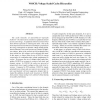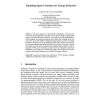119 search results - page 8 / 24 » Static Energy Reduction Techniques for Microprocessor Caches |
ICCD
2007
IEEE
14 years 4 months ago
2007
IEEE
The cache hierarchy of state-of-the-art—especially multicore—microprocessors consumes a significant amount of area and energy. A significant amount of research has been devo...
HPCA
2006
IEEE
14 years 8 months ago
2006
IEEE
With reducing feature size, increasing chip capacity, and increasing clock speed, microprocessors are becoming increasingly susceptible to transient (soft) errors. Redundant multi...
ISLPED
2006
ACM
14 years 1 months ago
2006
ACM
In a few technology generations, limitations of fabrication processes will make accurate design time power estimates a daunting challenge. Static leakage current which comprises a...
PATMOS
2007
Springer
14 years 1 months ago
2007
Springer
The deep submicron semiconductor technologies will make the worst-case design impossible, since they can not provide design margins that it requires. Research directions should go ...
ICCD
2005
IEEE
14 years 4 months ago
2005
IEEE
Energy dissipation from the issue queue and register file constitutes a large portion of the overall energy budget of an aggressive dynamically scheduled microprocessor. We propo...


